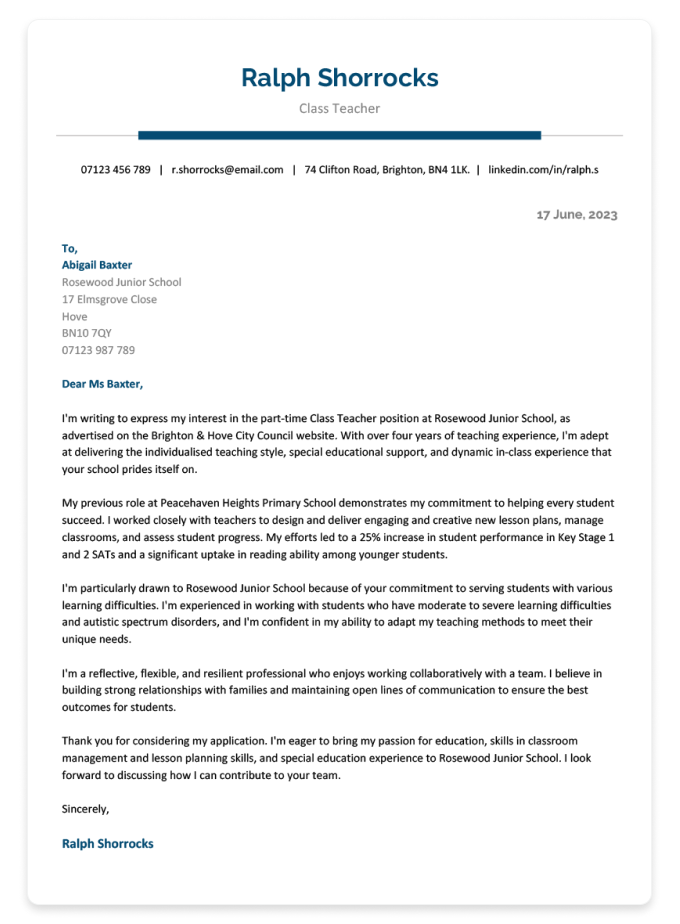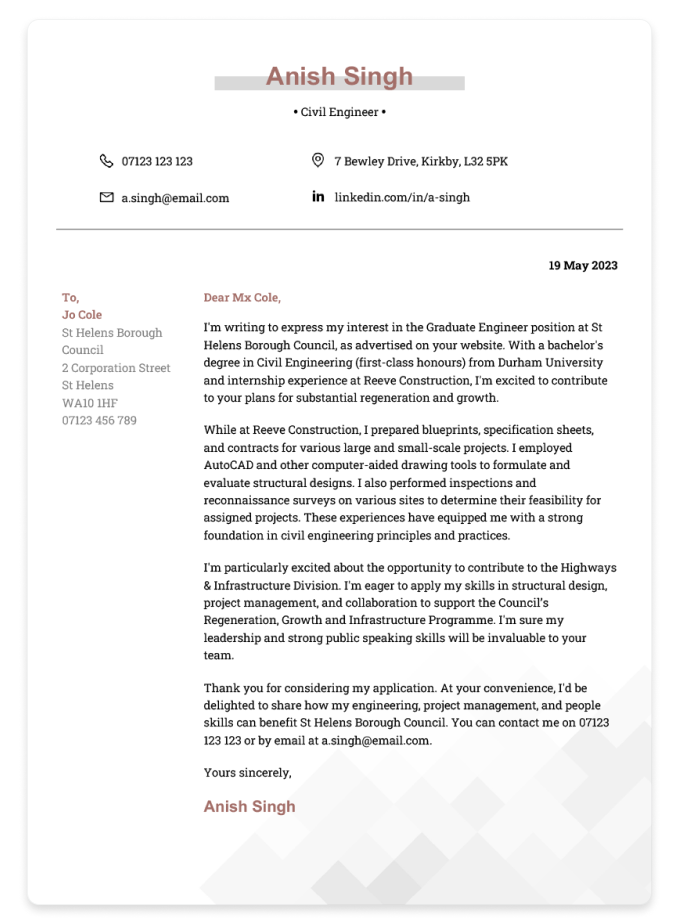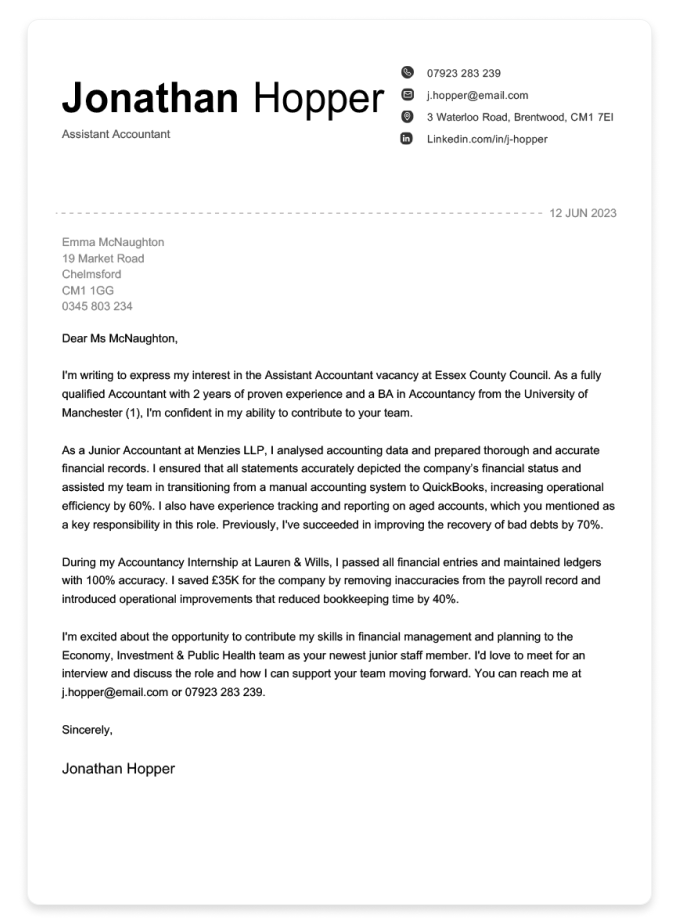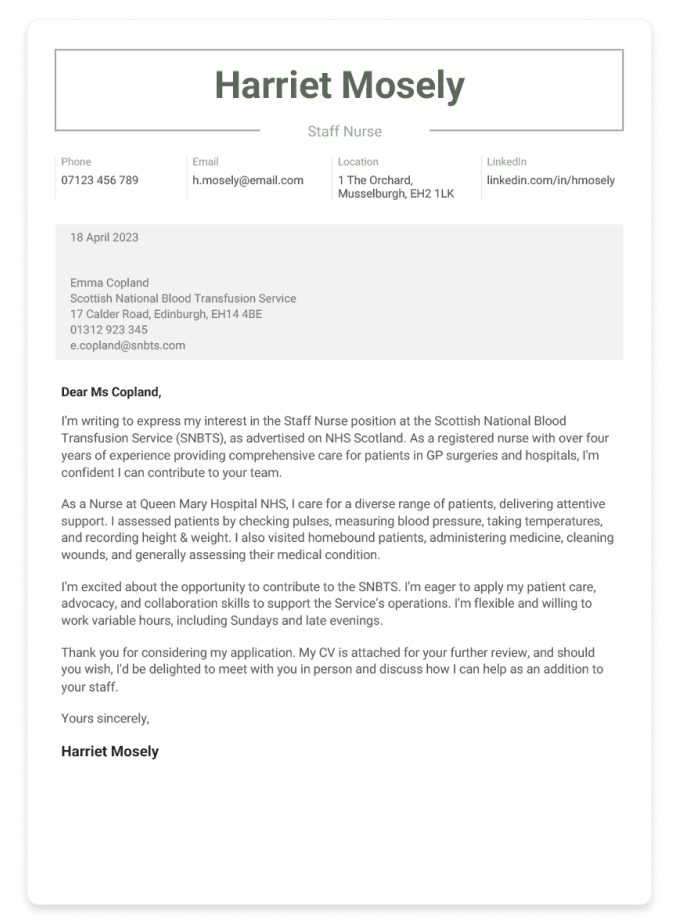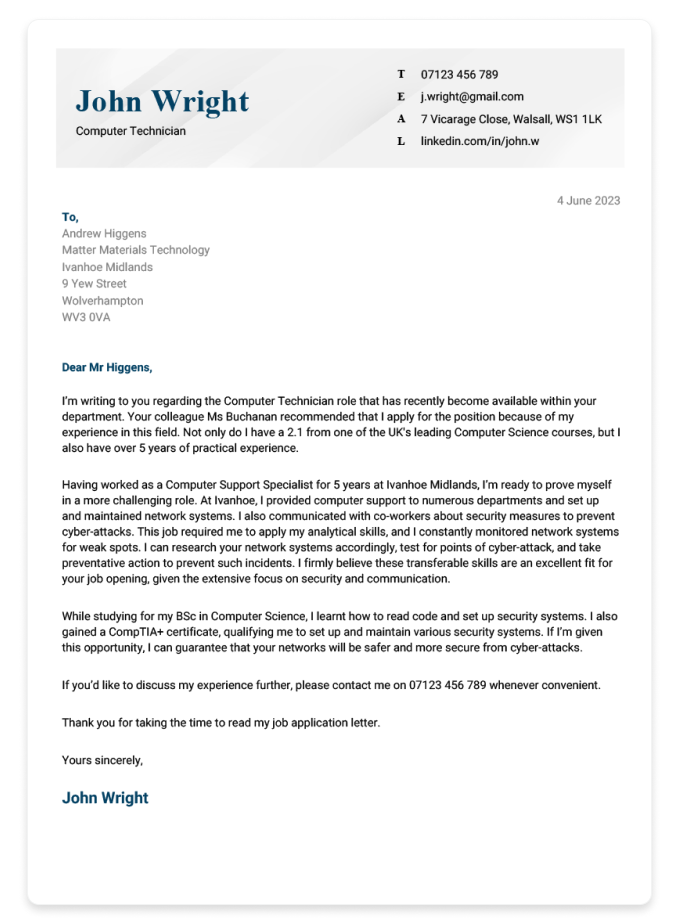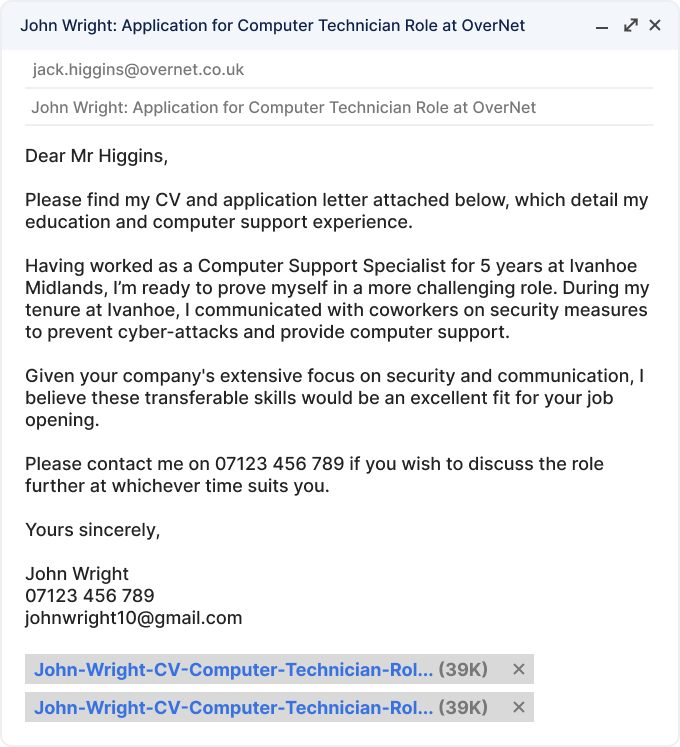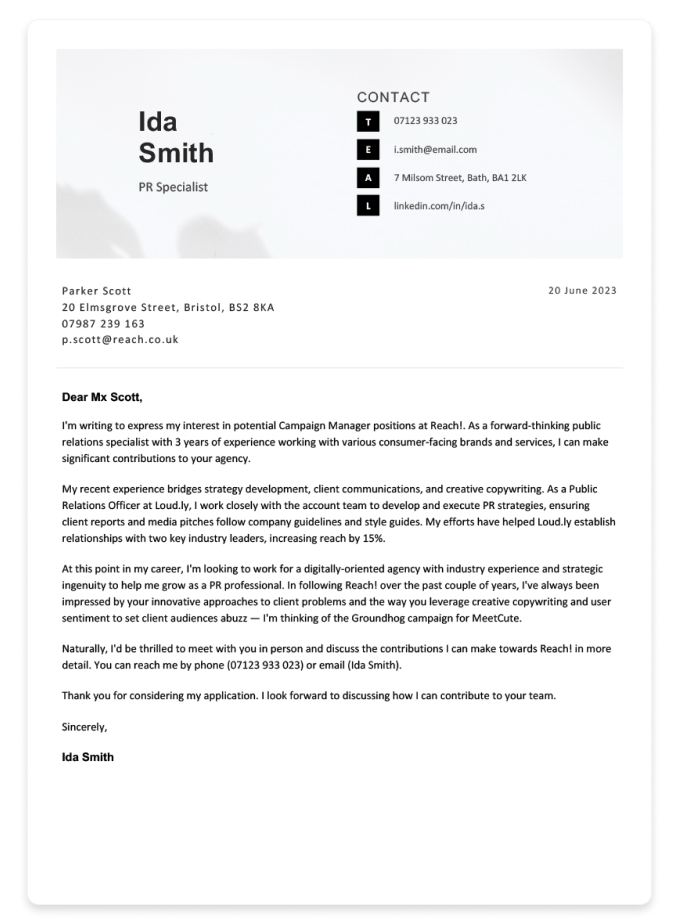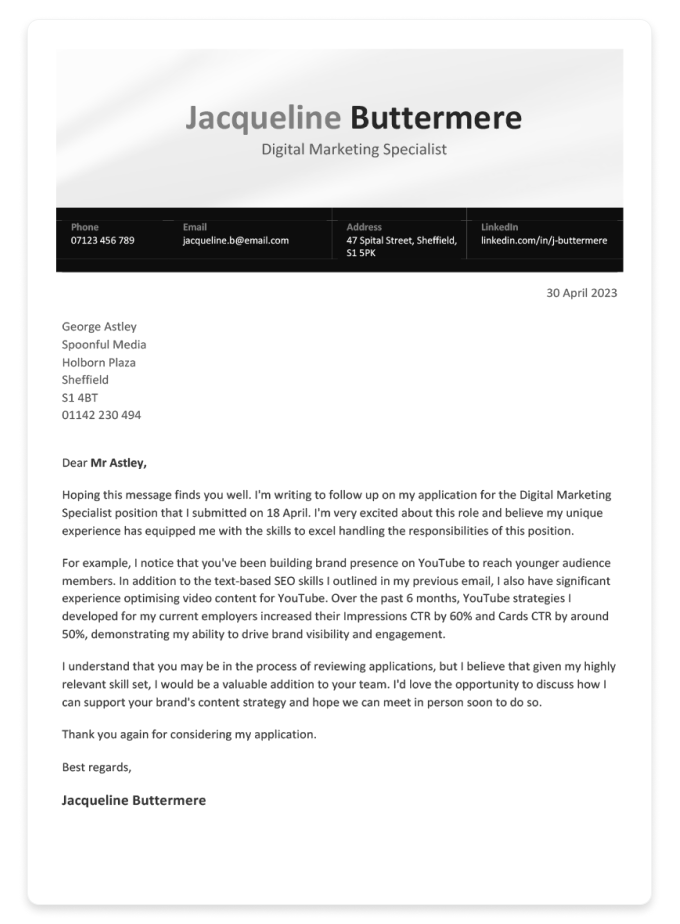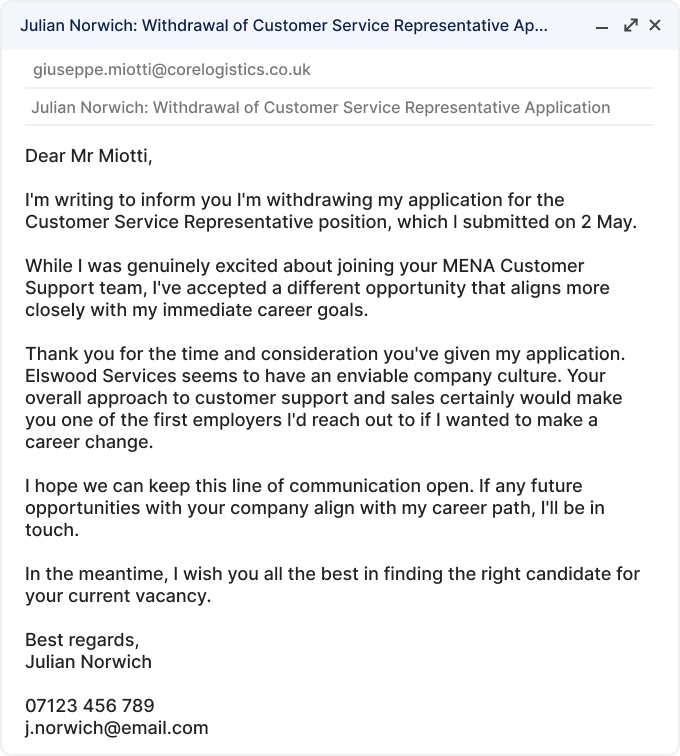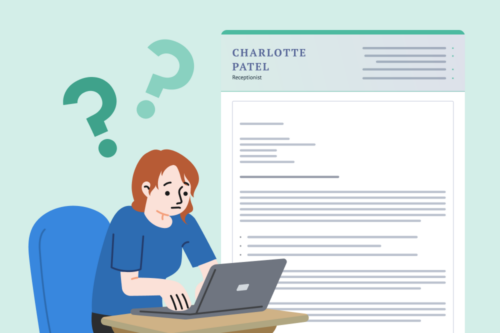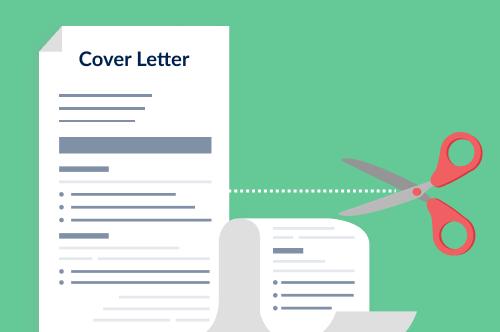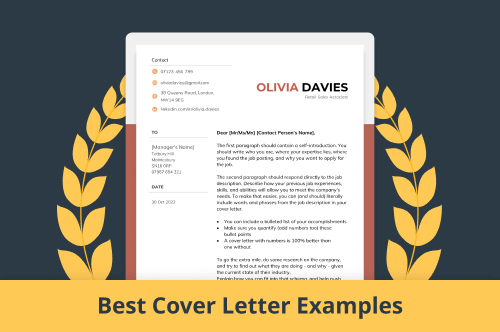Your job application letter (also known as a cover letter) is your chance to stand out from the competition by showing the employer how your experience, skills, and work ethic qualify you for their specific job opportunity.
If the purpose of a CV is to tell the employer what skills you offer them, the purpose of your job application is to explain why those skills are important and how the employer can benefit from them.
But even if you’ve already read up on how to write a cover letter, putting one together can be difficult.
Check out these nine job application cover letter examples, a cover letter template, and writing tips to get over your writer’s block and put together a letter that dazzles the employer and moves your name onto their interview shortlist.
9 job application cover letter examples
The best tone, structure, and content for your job application letter depends on the job you’re applying for and the type of company that’s reviewing your application.
Here are nine examples of cover letters for different job applications and cover letter formats for:
- teaching jobs
- engineering jobs
- accounting jobs
- nursing jobs
- IT jobs
- emailing an application letter
- asking about possible job opportunities
- following up on a previous job application
- withdrawing a job application
Looking for a more specific example? Check out our cover letter examples page, with tailored letters and tips for various jobs and industries.
1. Teaching job application letter
Enthusiasm, people skills, and classroom results are valuable elements when writing a teacher cover letter.
Tell the employer why you’re interested in their learning centre by spotlighting values, teaching approaches, or specialist areas that match your skills and interests.
Previous experience is always a plus, so if you’ve taught in a classroom setting before, be sure to highlight relevant details:
- Class sizes
- Methodologies
- Important classroom metrics (e.g., student performance)
Here’s an application letter for a teaching job that highlights all the right traits:
Teaching Application Letter Sample (Text Version)
17 June 2023
Abigail Baxter
Rosewood Junior School
17 Elmsgrove Close
Hove
BN10 7QY
07123 987 789
Dear Ms Baxter,
I’m writing to express my interest in the part-time Class Teacher position at Rosewood Junior School, as advertised on the Brighton & Hove City Council website. With over four years of teaching experience, I’m adept at delivering the individualised teaching style, special educational support, and dynamic in-class experience that your school prides itself on.
My previous role at Peacehaven Heights Primary School demonstrates my commitment to helping every student succeed. I worked closely with teachers to design and deliver engaging and creative new lesson plans, manage classrooms, and assess student progress. My efforts led to a 25% increase in student performance in Key Stage 1 and 2 SATs and a significant uptake in reading ability among younger students.
I’m particularly drawn to Rosewood Junior School because of your commitment to serving students with various learning difficulties. I’m experienced in working with students who have moderate to severe learning difficulties and autistic spectrum disorders, and I’m confident in my ability to adapt my teaching methods to meet their unique needs.
I’m a reflective, flexible, and resilient professional who enjoys working collaboratively with a team. I believe in building strong relationships with families and maintaining open lines of communication to ensure the best outcomes for students.
Thank you for considering my application. I’m eager to bring my passion for education, skills in classroom management and lesson planning skills, and special education experience to Rosewood Junior School. I look forward to discussing how I can contribute to your team.
Sincerely,
Ralph Shorrocks
Download This Job Application Letter Sample
2. Engineering job application letter
Whether the employer is looking for data analysis or mastery of AutoCAD, you’ll need to demonstrate the right technical skills to be considered for your dream engineering job.
This cover letter for an engineering job makes a strong case for the applicant by highlighting their qualifications, practical experience, and knowledge of computer-aided design software:
Engineering Application Letter Sample (Text Version)
19 May 2023
Jo Cole
St Helens Borough Council
2 Corporation Street
St Helens
WA10 1HF
07123 456 789
Dear Mx Cole,
I’m writing to express my interest in the Graduate Engineer position at St Helens Borough Council, as advertised on your website. With a bachelor’s degree in Civil Engineering (first-class honours) from Durham University and internship experience at Reeve Construction, I’m excited to contribute to your plans for substantial regeneration and growth.
While at Reeve Construction, I prepared blueprints, specification sheets, and contracts for various large and small-scale projects. I employed AutoCAD and other computer-aided drawing tools to formulate and evaluate structural designs. I also performed inspections and reconnaissance surveys on various sites to determine their feasibility for assigned projects. These experiences have equipped me with a strong foundation in civil engineering principles and practices.
I’m particularly excited about the opportunity to contribute to the Highways & Infrastructure Division. I’m eager to apply my skills in structural design, project management, and collaboration to support the Council’s Regeneration, Growth and Infrastructure Programme. I’m sure my leadership and strong public speaking skills will be invaluable to your team.
Thank you for considering my application. At your convenience, I’d be delighted to share how my engineering, project management, and people skills can benefit St Helens Borough Council. You can contact me on 07123 123 123 or by email at a.singh@email.com.
Yours sincerely,
Anish Singh
Download This Job Application Letter Sample
3. Accounting job application letter sample
Already using hard numbers to optimise your CV work experience section? Do the same when you write your job application letter.
Hard numbers are highly effective at highlighting key achievements on a cover letter because:
- numbers stand out on a page full of words
- they’re easy for employers to understand and remember
This accounting job application letter does an excellent job of quantifying the applicant’s achievements. And as accountancy is a highly results-oriented field, the employer will find the approach highly persuasive:
Accounting Application Letter Sample (Text Version)
12 June 2023
Emma McNaughton
19 Market Road
Chelmsford
CM1 1GG
0345 803 234
Dear Ms McNaughton,
I’m writing to express my interest in the Assistant Accountant vacancy at Essex County Council. As a fully qualified Accountant with 2 years of proven experience and a BA in Accountancy from the University of Manchester (1), I’m confident in my ability to contribute to your team.
As a Junior Accountant at Menzies LLP, I analysed accounting data and prepared thorough and accurate financial records. I ensured that all statements accurately depicted the company’s financial status and assisted my team in transitioning from a manual accounting system to QuickBooks, increasing operational efficiency by 60%. I also have experience tracking and reporting on aged accounts, which you mentioned as a key responsibility in this role. Previously, I’ve succeeded in improving the recovery of bad debts by 70%.
During my Accountancy Internship at Lauren & Wills, I passed all financial entries and maintained ledgers with 100% accuracy. I saved £35K for the company by removing inaccuracies from the payroll record and introduced operational improvements that reduced bookkeeping time by 40%.
I’m excited about the opportunity to contribute my skills in financial management and planning to the Economy, Investment & Public Health team as your newest junior staff member. I’d love to meet for an interview and discuss the role and how I can support your team moving forward. You can reach me at j.hopper@email.com or 07923 283 239.
Sincerely,
Jonathan Hopper
Download This Job Application Letter Sample
4. Nursing job application letter example
If you’re applying for a nursing position that asks you to submit a CV, you’ll need to send in a nursing cover letter, too.
This cover letter for a nursing job application demonstrates how you should focus on outlining what you can do for the employer rather than what the job will do for you:
Nursing Job Application Letter Sample (Text Version)
18 April 2023
Emma Copland
Scottish National Blood Transfusion Service
17 Calder Road
Edinburgh
EH14 4BE
Dear Ms Copland,
I’m writing to express my interest in the Staff Nurse position at the Scottish National Blood Transfusion Service (SNBTS), as advertised on NHS Scotland. As a registered nurse with over four years of experience providing comprehensive care for patients in GP surgeries and hospitals, I’m confident I can contribute to your team.
As a Nurse at Queen Mary Hospital NHS, I care for a diverse range of patients, delivering attentive support. I assessed patients by checking pulses, measuring blood pressure, taking temperatures, and recording height & weight. I also visited homebound patients, administering medicine, cleaning wounds, and generally assessing their medical condition.
I’m excited about the opportunity to contribute to the SNBTS. I’m eager to apply my patient care, advocacy, and collaboration skills to support the Service’s operations. I’m flexible and willing to work variable hours, including Sundays and late evenings.
Thank you for considering my application. My CV is attached for your further review, and should you wish, I’d be delighted to meet with you in person and discuss how I can help as an addition to your staff.
Yours sincerely,
Harriet Mosely
Download This Job Application Letter Sample
5. IT job application letter example
If you’re applying for an IT job, your application letter should, at a minimum, include any qualifications or certifications the role requires.
But to win over the employer, you’ll need to show them what benefits these experiences will bring to their team if they hire you.
See how this IT job applicant highlights their relevant qualifications but also teases how they could use these skills to help the employer if hired as a member of their staff:
IT Job Application Letter Sample (Text Version)
4 June 2023
Andrew Higgens
Matter Materials Technology
Ivanhoe Midlands
9 Yew Street
Wolverhampton
WV3 0VA
Dear Mr Higgens,
I’m writing to you regarding the Computer Technician role that has recently become available within your department. Your colleague Ms Buchanan recommended that I apply for the position because of my experience in this field. Not only do I have a 2.1 from one of the UK’s leading Computer Science courses, but I also have over 5 years of practical experience.
Having worked as a Computer Support Specialist for 5 years at Ivanhoe Midlands, I’m ready to prove myself in a more challenging role. At Ivanhoe, I provided computer support to numerous departments and set up and maintained network systems. I also communicated with coworkers about security measures to prevent cyber-attacks. This job required me to apply my analytical skills, and I constantly monitored network systems for weak spots. I can research your network systems accordingly, test for points of cyber-attack, and take preventative action to prevent such incidents. I firmly believe these transferable skills are an excellent fit for your job opening, given the extensive focus on security and communication.
While studying for my BSc in Computer Science, I learnt how to read code and set up security systems. I also gained a CompTIA+ certificate, qualifying me to set up and maintain various security systems. If I’m given this opportunity, I can guarantee that your networks will be safer and more secure from cyber-attacks.
If you’d like to discuss my experience further, please contact me on 07123 456 789 whenever convenient.
Thank you for taking the time to read my job application letter.
Yours sincerely,
John Wright
Download This Job Application Letter Sample
Other types of job application letters
Depending on your current situation or application, you might need to use a different format for your job application or write your cover letter differently.
Here are a few examples of job application letters that have different formats or end purposes:
6. Email cover letter
Here’s an example of an email application letter that doesn’t include the date or employer’s contact information:
Email Job Application Letter Sample (Text Version)
Dear Mr Higgins,
Please find my CV and application letter attached below, which detail my education and computer support experience.
Having worked as a Computer Support Specialist for 5 years at Ivanhoe Midlands, I’m ready to prove myself in a more challenging role. During my tenure at Ivanhoe, I communicated with coworkers on security measures to prevent cyber-attacks and provide computer support.
Given your company’s extensive focus on security and communication, I believe these transferable skills would be an excellent fit for your job opening.
Please contact me on 07123 456 789 if you wish to discuss the role further at whichever time suits you.
Yours sincerely,
John Wright
07123 456 789
johnwright10@gmail.com
7. Speculative job application letter
A speculative job application letter is a covering letter you send out when you want to find out about possible job opportunities.
You write speculative job application letters differently from traditional covering letters, normally focusing on why the applicant wants to work for the employer rather than why they’re qualified for a specific job. Here’s how:
Speculative Job Application Letter Sample (Text Version)
20 June 2023
Parker Scott
20 Elmsgrove Street
Bristol
BS2 8KA
Dear Mx Scott,
I’m writing to express my interest in potential Campaign Manager positions at Reach!. As a forward-thinking public relations specialist with 3 years of experience working with various consumer-facing brands and services, I can make significant contributions to your agency.
My recent experience bridges strategy development, client communications, and creative copywriting. As a Public Relations Officer at Loud.ly, I work closely with the account team to develop and execute PR strategies, ensuring client reports and media pitches follow company guidelines and style guides. My efforts have helped Loud.ly establish relationships with two key industry leaders, increasing reach by 15%.
At this point in my career, I’m looking to work for a digitally-oriented agency with industry experience and strategic ingenuity to help me grow as a PR professional. In following Reach! over the past couple of years, I’ve always been impressed by your innovative approaches to client problems and the way you leverage creative copywriting and user sentiment to set client audiences abuzz — I’m thinking of the Groundhog campaign for MeetCute.
Naturally, I’d be thrilled to meet with you in person and discuss the contributions I can make towards Reach! in more detail. You can reach me by phone (07123 933 023) or email (Ida Smith).
Thank you for considering my application. I look forward to discussing how I can contribute to your team.
Sincerely,
Ida Smith
Download This Job Application Letter Sample
8. Follow-up letter for a job application
Perhaps the employer is experiencing delays. Perhaps they just have a lot of CVs to read through. Either way, you haven’t heard back from them for a couple of weeks.
It’s time to send a follow-up letter.
Follow-up letters politely remind the employer about your job application and reaffirm your interest in working for them. If you want to make more of an impact, you can also highlight a relevant skill or achievement that qualifies you for the role.
Using the same cover letter template you used for your original job application will make you appear more professional and demonstrate your attention to detail.
Follow-Up Letter for a Job Application Letter Sample (Text Version)
30 April 2023
George Astley
Spoonful Media
Holborn Plaza
Sheffield
S1 4BT
01142 230 494
Dear Mr Astley,
Hoping this message finds you well. I’m writing to follow up on my application for the Digital Marketing Specialist position that I submitted on 18 April. I’m very excited about this role and believe my unique experience has equipped me with the skills to excel handling the responsibilities of this position.
For example, I notice that you’ve been building brand presence on YouTube to reach younger audience members. In addition to the text-based SEO skills I outlined in my previous email, I also have significant experience optimising video content for YouTube. Over the past 6 months, YouTube strategies I developed for my current employers increased their Impressions CTR by 60% and Cards CTR by around 50%, demonstrating my ability to drive brand visibility and engagement.
I understand that you may be in the process of reviewing applications, but I believe that given my highly relevant skill set, I would be a valuable addition to your team. I’d love the opportunity to discuss how I can support your brand’s content strategy and hope we can meet in person soon to do so.
Thank you again for considering my application.
Best regards,
Jacqueline Buttermere
Download This Follow-Up Letter Sample
9. Sample withdrawal letter for a job application
If you’ve accepted another job offer or decided to take your job search in another direction, you might find yourself writing a withdrawal letter to inform an employer that you don’t wish to work for them anymore.
While it might be easier just to stop communicating with an employer after you decide to cancel your application, writing a courteous withdrawal letter has notable advantages:
- You can keep a line of communication open with the employer
- The employer might contact you first about new opportunities
When writing a withdrawal letter, be polite, apologetic, and give a reason for your decision to withdraw your application. Here’s an example withdrawal letter, written for email:
Withdrawal Letter for a Job Application (Text Version)
Dear Mr Miotti,
I’m writing to inform you I’m withdrawing my application for the Customer Service Representative position, which I submitted on 2 May.
While I was genuinely excited about joining your MENA Customer Support team, I’ve accepted a different opportunity that aligns more closely with my immediate career goals.
Thank you for the time and consideration you’ve given my application. Elswood Services seems to have an enviable company culture. Your overall approach to customer support and sales certainly would make you one of the first employers I’d reach out to if I wanted to make a career change.
I hope we can keep this line of communication open. If any future opportunities with your company align with my career path, I’ll be in touch.
In the meantime, I wish you all the best in finding the right candidate for your current vacancy.
Best regards,
Julian Norwich
07123 456 789
j.norwich@email.com
Job Application Letter Template
Below is a template you can copy and paste into your word processor and personalise to suit the specific job you’re applying for.
If you’re not sure how to edit the template, read through this guide on what to include in a cover letter.
If you sign your name, leave three lines to write the signature after printing your letter. If you’re emailing your job application letter, skip a line and write your name and contact details.
How to write a job application letter (3 tips)
Below are three ways to enhance your application letter:
1. Use correct formatting
To use proper job application letter formatting, set your font size to between 10.5 points and 12 points. Smaller font sizes than 10.5 points are difficult to read, while font sizes larger than 12 points appear unprofessional.
Keep your page margins between 1.25 cm and 2.5 cm. Use a good cover letter font like Times New Roman or Arial for your application letter so employers can easily read your application letter.
Always use the same font for your CV and cover letter as this shows attention to detail. An easy way to ensure your application documents match is to use an online CV creator that also offers a cover letter builder.
Also, save your job application letter as either a .docx or PDF file or according to the job description.
2. Write to enhance (not parrot) your CV
Your job application letter accompanies your CV, so there’s no need to repeat information across both documents.
Instead, treat your CV as a factual overview of your abilities and accomplishments. List what you can do and what you have done.
Then use your job application letter to explain how your experience is relevant to the job. Specify how you can help the employer by bringing your skill set to their team.
Remember to write in a personable tone. Your job application letter is often your one chance to show the employer your personality before they decide whether to interview you. Writing in an appropriate voice will make your application more engaging and memorable.
3. Tailor your application letter to the job advert
With each new job application, adjust your application letter’s content depending on the job.
Companies use applicant tracking systems (ATS) to find ideal candidates, so ensure your letter gets past the ATS by using the exact keywords you see from the job advert.
Customised descriptions of your skill sets and work history also show employers you’ve put effort into your application letter and understand what qualifications they’re looking for.

